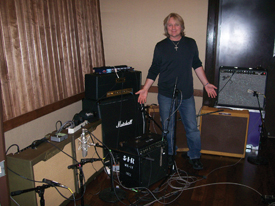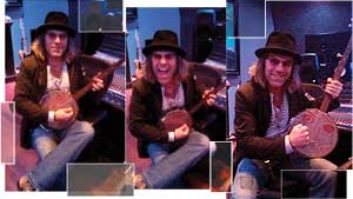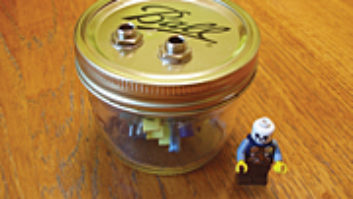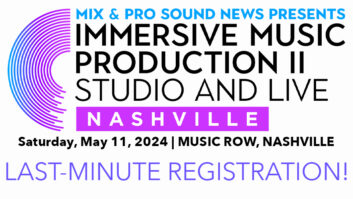
Skin Deep” />
Tom Hambridge in Blackbird Studio D during sessions for Skin Deep
Photo: Peter Cooper
When it came time to record Buddy Guy, Tom Hambridge figured Nashville was the best place to make an album of ferocious Chicago blues.
“I can put together a team down here that can rival anything, anywhere in the world,” says Hambridge, who produced Guy’s Grammy-nominated Skin Deep. “There’s more done down here by 10:30 in the morning than happens all day in most cities. People are up at sunrise, writing songs and making music. And they get real good and real efficient.”
That’s not to say that Hambridge — who has also produced Grammy-nominated albums for Johnny Winter and Susan Tedeschi, and who has written songs recorded by Lynyrd Skynyrd, George Thorogood, Delbert McClinton, Montgomery Gentry and others — had anything in mind that approached a polished “Nashville Sound.” And while Hambridge chose to work at Blackbird’s Studio D on the world’s largest (96 channels, 192 inputs, 200 faders) API Legacy Plus, he was as interested in vibe as in gear. Hambridge and engineer Vance Powell (The Raconteurs, Jars of Clay, Martina McBride) set up the floor to look more like a music store than a recording studio.
“This is Buddy Guy, and we wanted him to record the way he plays, and that’s loud and wild,” Hambridge says. “So we strung six amps together, and everything’s maxed out on those amps. All six amps were wide-open and used on every song. The sound is in Buddy’s fingers and in all these amps. Each amp was recorded to its own track in Pro Tools so we could change levels if we wanted to later. After we had complete takes, we printed a guitar mix through the fantastic chamber at Blackbird, and we wound up with a total of 11 guitar tracks.”
Powell miked Guy’s Chicago Blues Box amps — they’re similar to the 1959 Fender Bassman — with a Neumann U67 and a Shure SM57 placed close together. He brought in four other amps, at first to give Guy “choices,” though the first time Guy played through the six amps at once, he was sold on the combo platter. So then there was the Marshall Super Lead 100 through a 4×12 cabinet with an SM57, an early ’60s Fender Vibraverb with a Royer 121 ribbon mic, a genuine 1959 Bassman with an AEA R92, and a 100-watt MesaBoogie combo with a Royer 122.
“I also used a Neumann M50, compressed with an 1176, as a room mic,” Powell says. “All mics went into a rack of Neve 1073s to the API console.”
So that’s the setup — oh, and the classic Buddy Guy amp setup is treble and mids up to 10, and bass on 3 — but that’s not what is causing Guy to say that this may be the best album of his 50-year career. Hubris isn’t what’s causing him to say that, either, if we’re to believe the Grammy nomination and the glowing reviews from a bevy of critics.
“Buddy told me he’d made a lot of records where he said he didn’t know the material and didn’t feel associated with the material,” Hambridge says. “He didn’t like a lot of the things he had done. He’s a wonderful person and a legend, and he’s soft-spoken and not apt to speak up if he’s uncomfortable. He asked what I would do, and I said, ‘I would build the house together. Start by digging the ground.’”
By that, Hambridge means that he helps write the songs, finds the musicians, plays drums (though he brought in Richie Hayward of Little Feat for two tracks) and writes arrangements. What’s different about Hambridge’s work is that all that involvement doesn’t necessarily result in a “Hambridge Sound.” He’s more interested in helping create something unique to the artist.
“This started with me riding the bus with Buddy, and listening to him talk about his life,” Hambridge recalls. “One time, he said, ‘You know, Tom, I’ve been in this business a long time and alligators is my associates.’ Alligators, like business people. So then I went back home to Nashville and wrote, ‘When I was a little boy, I used to crawl around on the ground with rattlesnakes/Now I’m a full-grown man, alligators is my associates.’”
Guy smiled when he heard the demos Hambridge created in Nashville. And then he often weighed in with a story or a fact-check that would send Hambridge back to edit the work. In the end, they arrived at something Guy felt was personal and even revelatory. During the recording sessions, Guy said he sometimes went back to his hotel room, listened to the roughs and cried. And during the sessions, Hambridge took care to get whole takes rather than parsing things, and he took care to ignore any impulse to keep things safe or controlled.
“Sometimes, Buddy will play something that isn’t even in the key,” Hambridge says. “And it’s like, ‘What was that? Was that even a note? It’s in between notes. Was it in time? I don’t even know.’ Well, some of those places are the magical highlights. You’ll see someone writing about those places later on, saying, ‘The lick he did there, no one has even attempted.’ So that’s music. And that’s Buddy Guy. Why would I slick that up to make it sound like something that’s been done already?”
Send Nashville news to
peter@petercoopermusic.com.




